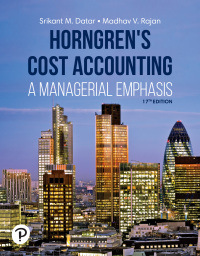I have asked this question 3 times with no response.
How do I calculate the Fixed Manufacturing Overhead for questions b through g for the below Kallapur Company question?
Thanks for your time.
f. Kallapur's production manager believes that design changes would reduce the number of set-ups required for QUIN to 25. Fixed overhead costs for set-ups would remain unchanged. What will be the impact of the design changes on the manufacturing costs of both products? Which of the products will earn the desired return? g. An alternative to the design change is to purchase a new machine that will reduce the number of set-ups for KAPI to 20 and the number of set-ups for QUIN to 80. The machine will also reduce fixed set-up costs to $200,000. Calculate the manufacturing costs for each product if the machine is purchased. Should QUIN be redesigned or should the machine be purchased? Why?PROBLEM 19.2A Activity-Based Management and Target Costing ( Lo19-2, & L019-3, 2 LO19-4. & L019-5 Page 378 Kallapur Company manufactures two products: KAPI, which sells for $120; and QUIN, which sells for $220. Estimated cost and production data for the current year are as follows. KAPI QUIN Direct materials cost $30 $45 Direct labor cost (@ $12/hr) $24 $60 Estimated production (units) 25.000 15,000 In addition, fixed manufacturing overhead is estimated to be $2,000,000 and variable overhead is estimated to equal $3 per direct labor hour. Kallapur desires a 15 percent return on sales for all of its products. Instructions a. Calculate the target cost for both KAPI and QUIN. b. Estimate the total manufacturing cost per unit of each product if fixed overhead costs are assigned to products on the basis of estimated production in units. Which of the products is earning the desired return? c. Recalculate the total manufacturing cost per unit if fixed overhead costs are assigned to products on the basis of direct labor hours. Which of the products is earning the desired return? d. On the basis of the confusing results of parts b and c, Kallapur's manager decides to perform an activity analysis of fixed overhead. The results of the analysis are as follows. Demands Activity Costs Driver KAPI QUIN Machine set-ups $ 400.000 # of set-ups 100 100 Purchase orders 600.000 # of orders 200 100 Machining 500,000 # of machine-hours 2,000 6.000 Inspection 200.000 # of batches 50 30 Shipping to customers 300.000 # of shipments 300 200 Total fixed overhead $2,000,000 Estimate the total manufacturing cost per unit of each product if activity-based costing is used for assigning fixed overhead costs. Under this method, which product is earning the desired return? e. What proportion of fixed overhead is value-added? In attempting to reach the target cost for QUIN, which activity would you look to improving first and why








